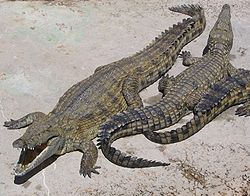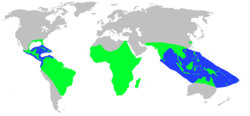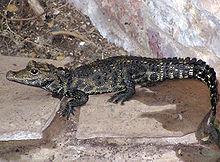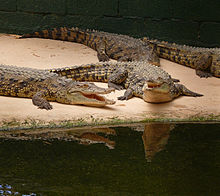- Crocodilia
-
Crocodilians
Temporal range: Cretaceous - Recent, 84–0 Ma
Nile crocodiles (Crocodylus niloticus) Scientific classification 
Kingdom: Animalia Phylum: Chordata Class: Reptilia Superorder: Crocodylomorpha clade: Eusuchia Order: Crocodylia
Owen, 1842Subgroups - Brevirostres
- Alligatoroidea
- Crocodyloidea
- Gavialoidea

Marine and freshwater ranges of living crocodilians Crocodilia (or Crocodylia) is an order of large reptiles that appeared about 84 million years ago in the late Cretaceous Period (Campanian stage). They are the closest living relatives of birds, as the two groups are the only known survivors of the Archosauria.[1] Members of the crocodilian total group, the clade Crurotarsi, appeared about 220 million years ago in the Triassic Period and exhibited a wide diversity of forms during the Mesozoic Era.
Although the term 'crocodiles' is sometimes used to refer to alligators, caiman, and gharials, or even to their distant prehistoric relatives the marine crocodiles, a less ambiguous vernacular term for this group is 'crocodilians'.
Contents
Spelling
The group is often spelled 'Crocodylia' for consistency with the genus Crocodylus (Laurenti, 1768). However, Richard Owen used the -i- spelling when he published the name in 1842, so it is generally preferred in the scientific literature.[citation needed] The -i- spelling is also a more accurate Latinization of the Greek κροκόδειλος (crocodeilos, literally "pebble-worm", referring to the texture and shape of the animal). However, the y-spelling is increasingly common, especially in the context of phylogeny-based names in which Crocodylia is limited to the crown group.
Description
 Size comparison of the largest recorded examples of several crocodilian species, including two prehistoric (from left): Sarcosuchus imperator, Deinosuchus hatcheri, gharial, Nile crocodile, and American alligator.
Size comparison of the largest recorded examples of several crocodilian species, including two prehistoric (from left): Sarcosuchus imperator, Deinosuchus hatcheri, gharial, Nile crocodile, and American alligator.
The smallest species of crocodilian is the Cuvier's Dwarf Caiman[2] and the largest is the Saltwater Crocodile.[3] The basic crocodilian body plan is a very successful one; modern species closely resemble their Cretaceous ancestors of 84 million years ago. Mammals, too, have adapted to this body plan at least once in history. One ancestral whale family, the Ambulocetidae, were aquatic predators living in rivers and lakes, and they filled an ecological niche similar to the crocodilians. Much earlier, before the age of reptiles, Amphibians like Prionosuchus and Platyoposaurus were the first animals to adopt this body plan and niche.
Locomotion
Crocodilians have a flexible semi-erect (semi-sprawled) posture. They can walk in low, sprawled "belly walk", or hold their legs more directly underneath them to perform the "high walk".[4] Most other reptiles can only walk in a sprawled position, and chameleons are the only modern reptiles with a more erect posture than crocodilians.[citation needed] The semi-erect posture makes it possible for some species to gallop on land if necessary.[4] An Australian species can reach a speed of over 16 km/h while galloping on an irregular forest floor.[5] Crocodilian ancestors, fast-moving terrestrial predators like the rauisuchians, actually had a fully erect posture, indicating that the sprawling and semi-erect posture of crocodilians evolved after they adapted to life as semi-aquatic ambush predators. Their ankle bones, or tarsi are highly modified. Modern crocodilian locomotion is not a primitive trait, but a specialization for their semi-aquatic lifestyle.
Teeth and jaws
All crocodilians have thecodont dentition (teeth set in bony sockets) but unlike mammals, they replace their teeth throughout life (though not in 'extreme' old-age). Juvenile crocodilians replace teeth with larger ones at a rate as high as 1 new tooth per socket every month. After reaching adult size in a few years, however, tooth replacement rates can slow to two years and even longer. Very old members of some species have been seen in an almost "edentulous" (toothless) state, after teeth have been broken and replacement slowed or ceased. The result of this is that a single crocodile can go through at least 3,000 teeth in its lifetime. Each tooth is hollow, and the new one is growing inside the old. In this way, a new tooth is ready once the old is lost.
 From the left: Heads of the Indian gharial (Gavialis gangeticus), American Alligator (Alligator mississippiensis), and an American Crocodile (Crocodylus acutus).
From the left: Heads of the Indian gharial (Gavialis gangeticus), American Alligator (Alligator mississippiensis), and an American Crocodile (Crocodylus acutus).
Crocodilians have a secondary bony palate that enables them to breathe when partially submerged, even if the mouth is full of water. Their internal nostrils open in the back of their throat, where a special part of the tongue called the "palatal valve" closes off their respiratory system when they are underwater. This way they can open their mouths underwater without choking. Most reptiles lack a secondary palate, but some skinks (family Scincidae) have evolved a bony secondary palate too, to varying degrees.
Crocodiles and gharials have modified salivary glands on their tongue (salt glands), which are used for excreting excess salt ions from their body. Alligators and caimans have them too, but here they are non-functioning. This indicates that at some point the common origin of the Crocodylia were adapted to saline/marine environments. This also explains their wide distribution across the continents (i.e. marine dispersal). Species like the saltwater crocodile (C. porosus) can survive protracted periods of time in the sea, and can hunt prey within this environment.
Crocodilians are often seen lying with their mouths open, a behavior called gaping. One of its functions is probably to cool them down, but since they also do this at night and when it is raining, it is possible that gaping has a social function as well.
Internal organs
Crocodilians lack a vomeronasal organ (except in the embryonic stage) and a urinary bladder.
Like mammals and birds and unlike other reptiles, crocodiles have a four-chambered heart. While the four-chambered heart is traditionally characteristic of endotherms, it is thought that the ectothermic crocodilia have a four-chambered heart because of an endothermic ancestry, originating in the archosaurs or in an earlier predecessor.[6] [7] When crocodilian ancestors transitioned back to aquatic ectothermy, it was advantageous for them to have a heart more akin to the normally three- or five-chambered heart found in most ectotherms. In order for their four-chambered heart to function more like the ectothermic heart, they adopted a mechanism for shunting blood in an alternative pathway through the heart.[6] The right ventricle has two arteries leaving it; a pulmonary artery, which goes to the lungs, and the left aortic arch, which goes to the body, or systemic circulation. There is also a hole, the foramen of Panizza, between the left and right aortic arches.[8] Because the left aortic arch goes directly to the gut, the shunting of oxygen depleted blood which is high in CO2 may serve to aid in creating stomach acid to assist in digesting bones from its prey.[9] Their blood has been shown to have strong antibacterial properties.[10]
Crocodilians have lungs with alveoli. They have a unique muscle called the diaphragmaticus that attaches to the liver and viscera and acts as a piston to assist in breathing. The diaphragmaticus is not homologous to the diaphragm of mammals and the proto-diaphragm of tegu lizards.[citation needed] Like other amniotes, crocodilian breathing uses muscles between the ribs to both increase and decrease thoracic volume. In addition, expiration is accomplished by contracting muscles to move the liver towards the head to rotate the pubic bones to decrease abdominal volume. Inspiration involves contraction of the diaphragmaticus muscle to push organs to the back of the body and other muscles to make space for these organs. In crocodilians, expiration is mostly passive (involves little muscle contraction) during rest while inspiration always involves muscle contraction.[11] Because many of these ventilatory muscles are used for maneuverability in water, and because the muscles were originally used for locomotion, it is possible that these muscles became ventilatory muscles after they evolved to move air around in the lungs for maneuverability.[12]
Crocodylians are known to swallow stones, gastroliths ("stomach-stones"), which act as a ballast in addition to aiding post-digestion processing of their prey. The crocodiylian stomach is divided into two chambers; the first one is described as being powerful and muscular, like a bird gizzard. This is where the gastroliths are found. The other stomach has the most acidic digestive system of any animal, and it can digest mostly everything from their prey; bones, feathers, and horns.
Crocodile sex determination is temperature-dependent; i.e., the sex of developing crocodilians is determined by the incubation temperature of the eggs. This means crocodilians do not have genetic sex determination, but instead have a form of environmental sex determination which is based upon the temperature embryos are subjected to early in their development.
Sensory organs
 West African dwarf crocodile from the forests of West and West Central Africa
West African dwarf crocodile from the forests of West and West Central Africa
Like all non-avian reptiles, crocodilians have a relatively small brain, but it is more advanced than in other reptiles. Among other things they have true cerebral cortexes.
As in many other aquatic or amphibious tetrapods, the eyes, ears, and nostrils are all located on the same plane. They see well during the day and may even have color vision, plus the eyes have a vertical, cat-like pupil which also gives them excellent night vision. The iris is silvery and a light reflecting layer of tapetum behind the retina greatly increases their ability to see in weak light and also makes their eyes appear to glow in the dark when a light is pointed at them. A third transparent eyelid, the nictitating membrane, protects their eyes underwater. However, they cannot focus under water, meaning other senses are more important when submerged.
While birds and most reptiles have a ring of bones around each eye which supports the eyeball (the sclerotic ring), the crocodiles lack these bones, just like mammals and snakes. The eardrums are located behind the eyes and are covered by a movable flap of skin. This flap closes, along with the nostrils and eyes, when they dive, preventing water from entering their external head openings. The middle ear cavity has a complex of bony air-filled passages and a branching eustachian tube. There is also a small muscle (which is also seen in geckos) next to or upon the stapes, the stapedius, which probably functions in the same way as the mammalian stapedius muscle does, damping strong vibrations.
The upper and lower jaws are covered with sensory pits, visible as small, black speckles on the skin, the crocodilian version of the lateral organ seen in fish and many amphibians, though arising from a completely different origin. These pigmented nodules encase bundles of nerve fibers that respond to the slightest disturbance in surface water, detecting vibrations and small pressure changes in water, making it possible for them to detect prey, danger, and intruders even in total darkness. These sense organs are known as DPRs (Dermal Pressure Receptors). While alligators and caimans only have them on their jaws, crocodiles have similar organs on almost every scale on their body. The function of the DPRs on the jaws are clear, but it is still not quite clear what the organs on the rest of the body in crocodiles actually do. They are probably doing the same as the organs on their jaws, but it seems as if they can do more than that, like assisting in chemical reception or even salinity detection.
Skin and skeleton
Main article: Crocodilian armorThe skin is covered with scales composed of the protein keratin (the same protein that forms hooves, horns, feathers, hair, claws, and nails in other tetrapods), which are shed individually. On the head the skin is actually fused to the bones of the skull. There are small plates of bone, called osteoderms or scutes, under the scales. Like the scales comprising the shell of a turtle, or the cross-section of a tree trunk, crocodile osteoderms have annual growth rings, and by counting them it is possible to tell their age. Osteoderms are found especially on the back, and in some species also on the belly. The rows of scutes cover the crocodile's body from head to tail, forming a tough protective armor. Beneath the scales and osteoderms is another layer of armor, both strong and flexible and built of rows of bony overlapping shingles called osteoscutes, which are embedded in the animal's back tissue. The blood-rich bumpy scales seen on their backs act as solar panels.
Their spool-shaped vertebrae in their ancestors went from being biconcave to having a concave front and a convex back in the modern forms. This made the vertebral column more flexible and strong.
They possess ribs of dermal origin restricted to the sides of the ventral body wall. The collar bone (clavicle) is absent.
Differences between alligators and crocodiles
While alligators (and caimans) are often confused with crocodiles, they belong to two quite separate taxonomic families.
The most obvious external differences are visible in the head—alligators and caimans have wider and shorter heads, and a more U-shaped than V-shaped snout. The alligator's upper jaw is wider than its lower jaw, and the teeth in the lower jaw fit into small depressions in the upper jaw. The upper and lower jaws of the crocodiles are the same width, and teeth in the lower jaw fall along the edge or outside the upper jaw when the mouth is closed. When the crocodile's mouth is closed, the large fourth tooth in the lower jaw fits into a constriction in the upper jaw. For hard-to-distinguish specimens, the protruding tooth is the most reliable feature to define a species.[13] However, in captivity, alligators and caimans may show jaw deformities which result in lower teeth protruding.
Alligators lack the jagged fringe which appears on the hind legs and feet of the crocodile and have the toes of the hind feet webbed, not more than halfway to the tips. Alligators strongly prefer freshwater, while crocodiles can better tolerate seawater due to specialized glands for filtering out salt. However, both taxa can survive in either.
Both species of alligator also tend to be darker in color than crocodiles—often nearly black—but color is very dependent on water quality. Algae-laden waters produce greener skin, while tannic acid from overhanging trees can produce often darker skin.
When cleaning alligator pools, some zookeepers can tread on alligators without eliciting a response, though crocodiles almost invariably react aggressively and are for the most part more aggressive in their natural habitat.[14]
Evolution and classification
Eusuchia, a modern clade which includes the crown group Crocodilia, first appeared in the Lower Cretaceous of Europe. Isisfordia duncani lived approximately 95 to 98 million years ago, during the Cenomanian epoch of the Upper Cretaceous. Isisfordia is the second oldest known eusuchian, and the earliest crocodylomorph yet found in Australia. Eusuchians underwent a mass radiation during the Late Cretaceous and the Paleogene, in which they evolved into numerous forms, such as semi-aquatic dinosaur-eating species (Deinosuchus); hooved, terrestrial carnivores (Pristichampsus), and 'hatchet'-shaped skulled forms (Baru).
Crocodilian Snouts
Although crocodilians were thought of as living fossils for many years, review of their fossil record in the last decade has shown that their snout morphology has been continuously changing throughout evolutionary history.[15] Furthermore, snout and skull morphology seem to be functional adaptations to the selection pressures that crocodilians face from the diet in their environment.[16] For instance, long-snouted crocodilians, such as Gavialis gangeticus, that live in habitats where small, rapid, agile fish are the main food source need to be able to move, open and close their snouts rapidly through the water.[17] Thus, long snouts have evolved in such habitats in order to benefit from hydrodynamic efficiency since a long out-lever allows crocodilians to quickly open and close their jaws while in water.[18] On the other hand, the need for a strong mandible is crucial for short-snouted crocodilians, such as Alligator mississippiensis, which are found in habitats where large terrestrial vertebrates, amphibians, and fish are the food sources.[19] Thus, these crocodilians have evolved to increase the mechanical strength of their mandibles by developing a larger mass of M. ptergoideus posterior muscles.[20] Therefore, natural selection seems to lead to the evolution of an effective crocodilian snout by creating a mechanical compromise between bite force and hydrodynamic efficiency.[21]
Extant taxonomy
- Family Gavialidae
- Genus Gavialis
- Gharial (Gavialis gangeticus)
- Genus Gavialis
- Family Alligatoridae
- Genus Alligator
- American Alligator (Alligator mississippiensis)
- Chinese Alligator (Alligator sinensis)
- Genus Paleosuchus
- Cuvier's Dwarf Caiman (Paleosuchus palpebrosus)
- Smooth-fronted Caiman (Paleosuchus trigonatus)
- Genus Caiman
- Yacare Caiman (Caiman yacare)
- Spectacled Caiman (Caiman crocodilus)
- Broad-snouted Caiman (Caiman latirostris)
- Genus Melanosuchus
- Black Caiman (Melanosuchus niger)
- Genus Alligator
- Family Crocodylidae
- Genus Crocodylus
- American crocodile (Crocodylus acutus)
- Slender-snouted crocodile (Crocodylus cataphractus)
- Orinoco crocodile (Crocodylus intermedius)
- Freshwater crocodile (Crocodylus johnsoni)
- Philippine crocodile (Crocodylus mindorensis)
- Morelet's crocodile (Crocodylus moreletii)
- Nile crocodile (Crocodylus niloticus)
- New Guinea crocodile (Crocodylus novaeguineae)
- Mugger crocodile (Crocodylus palustris)
- Saltwater crocodile (Crocodylus porosus)
- Cuban crocodile (Crocodylus rhombifer)
- Siamese crocodile (Crocodylus siamensis)
- Genus Osteolaemus
- Dwarf crocodile (Osteolaemus tetraspis)
- Genus Tomistoma
- False gharial (Tomistoma schlegelii)
- Genus Crocodylus
Taxonomy
- Superorder Crocodylomorpha
- Order Crocodilia
- Superfamily Gavialoidea
- Family Gavialidae: gharials & false gharials
- Superfamily Alligatoroidea
- Family Alligatoridae
- Subfamily Alligatorinae: alligators
- Subfamily Caimaninae: caimans
- Family †Diplocynodontidae
- Family Alligatoridae
- Superfamily Crocodyloidea
- Family Crocodylidae
- Subfamily Crocodylinae: crocodiles
- Subfamily †Mekosuchinae
- Family Crocodylidae
- Superfamily Gavialoidea
- Order Crocodilia
Phylogeny
Cladogram after Brochu (1997).
Eusuchia Hylaeochampsa
Crocodilia Gavialoidea Eothoracosaurus
Thoracosaurus
Eosuchus
Brevirostres Alligatoroidea Globidonta Stangerochampsa
Brachychampsa
Crocodyloidea Prodiplocynodon
Asiatosuchus
Brachyuranochampsa
Crocodylidae
Fossil record
Neonate sized crocodilians fossils have been documented in the scientific literature.[22]
In popular culture
- Several science fiction movies have giant crocodilians as their stars, such as Alligator, Lake Placid, Primeval, DinoCroc, and Rogue.
References
- ^ "ADW: Crocodilia: Information". Animaldiversity.ummz.umich.edu. http://animaldiversity.ummz.umich.edu/site/accounts/information/Crocodilia.html. Retrieved 2009-04-05.
- ^ <http://www.flmnh.ufl.edu/cnhc/csp_ppal.htm>
- ^ <http://www.flmnh.ufl.edu/cnhc/csp_cpor.htm>
- ^ a b Britton, Adam. "Crocodilian Biology Database-Locomotion". http://www.flmnh.ufl.edu/cnhc/cbd-gb3.htm. Retrieved 2007-04-20.
- ^ Major Features of Vertebrate Evolution
- ^ a b Seymour, R.S.; C. L. Bennett-Stamper, S. D. Johnston, D. R. Carrier, G. C. Grigg (2004). "Evidence for endothermic ancestors of crocodiles at the stem of archosaur evolution". Physiological and Biochemical Zoology 77 (6): 1051–1067. doi:10.1086/422766. PMID 15674775.
- ^ Summers, A.P. (2005). "Evolution - Warm-hearted crocs". Nature 434 (7035): 833–834. doi:10.1038/434833a. PMID 15829945.
- ^ Axelsson, Michael; Craig E. Franklin (1997). "From anatomy to angioscopy: 164 years of crocodilian cardiovascular research, recent advances, and speculations". Comparative Biochemistry and Physiology A 188 (1): 51–62. doi:10.1016/S0300-9629(96)00255-1.
- ^ Farmer, C., Uriona, T.J., Olsen, D.B., Steenblick, M. and Sanders, K. (2008). "The right-to-left shunt of crocodilians serves digestion". Physiological and Biochemical Zoology 81 (2): 125–137. doi:10.1086/524150. PMID 18194087.
- ^ Crocodile blood shows anti-HIV activity
- ^ Farmer, Colleen G.; David R. Carrier (2000). "Pelvic aspiration in the american alligator (Alligator mississippiensis)". The Journal of Experimental Biology 203 (Pt 11): 1679–1687. PMID 10804158.
- ^ Uriona TJ, Farmer CG. 2008. Recruitment of the diaphragmaticus, ischiopubis and other respiratory muscles to control pitch and roll in the American alligator (Alligator mississippiensis). Journal of Experimental Biology 211: 1141-1147.
- ^ "Crocodilian Biology Database - FAQ - What's the difference between a crocodile and an alligator". Flmnh.ufl.edu. http://www.flmnh.ufl.edu/cnhc/cbd-faq-q1.htm. Retrieved 2009-04-05.
- ^ Guggisberg, C.A.W. (1972). Crocodiles: Their Natural History, Folklore, and Conservation. Newton Abbot: David & Charles. p. 195. ISBN 0715352725.
- ^ Brochu, C. A. 2003. Phylogenetic approaches toward crocodylian history. Annual Review of Earth and Planetary Sciences 31:357-397.
- ^ Pierce, S. E., K. D. Angielczyk, and E. J. Rayfield. 2008. Patterns of morphospace occupation and mechanical performance in extant crocodilian skulls: a combined geometric morphometric and finite element modeling approach. Journal of Morphology 269:840-864.
- ^ McHenry, C. R., P. D. Clausen, W. J. T. Daniel, M. B. Meers, and A. Pendharkar. 2006. Biomechanics of the rostrum in crocodilians: a comparative analysis using finite-element modeling. Anatomical Record Part a-Discoveries in Molecular Cellular and Evolutionary Biology 288A:827-849.
- ^ Pierce, S. E., K. D. Angielczyk, and E. J. Rayfield. 2009. Shape and mechanics in thalattosuchian (Crocodylomorpha) skulls: implications for feeding behaviour and niche partitioning. Journal of Anatomy 215:555-576.
- ^ Pierce, S. E., K. D. Angielczyk, and E. J. Rayfield. 2008. Patterns of morphospace occupation and mechanical performance in extant crocodilian skulls: a combined geometric morphometric and finite element modeling approach. Journal of Morphology 269:840-864.
- ^ Pierce, S. E., K. D. Angielczyk, and E. J. Rayfield. 2009. Shape and mechanics in thalattosuchian (Crocodylomorpha) skulls: implications for feeding behaviour and niche partitioning. Journal of Anatomy 215:555-576.
- ^ McHenry, C. R., P. D. Clausen, W. J. T. Daniel, M. B. Meers, and A. Pendharkar. 2006. Biomechanics of the rostrum in crocodilians: a comparative analysis using finite-element modeling. Anatomical Record Part a-Discoveries in Molecular Cellular and Evolutionary Biology 288A:827-849.
- ^ Tanke, D.H. and Brett-Surman, M.K. 2001. Evidence of Hatchling and Nestling-Size Hadrosaurs (Reptilia:Ornithischia) from Dinosaur Provincial Park (Dinosaur Park Formation: Campanian), Alberta, Canada. pp. 206-218. In: Mesozoic Vertebrate Life—New Research Inspired by the Paleontology of Philip J. Currie. Edited by D.H. Tanke and K. Carpenter. Indiana University Press: Bloomington. xviii + 577 pp.
External links
- Before Crocodiles, the Hairless Coyote
- International Crocodile Rescue
- Mikko's Phylogeny Archive Crocodyliformes
- Florida's Museum of Natural History's Crocodilians Natural History & Conservation site
Extant reptile orders by subclass Anapsida Diapsida CrocodiliaExtant Crocodilian species Kingdom: Animalia · Phylum: Chordata · Class: Sauropsida · (unranked): Archosauria · Superorder: CrocodylomorphaFamily Gavialidae Family Alligatoridae Alligatorinae
(Alligators)Caimaninae
(Caimans)Related articles on alligators, caimans, crocodiles and gharials Topics Human
interactionU.S. Alligator fatalities · Crocodile attacks · Alligator farm · Crocodile tears · Famous crocodiles and alligators · Sewer alligatorArchosauromorphs Primitive
ArchosauromorphsPrimitive
ArchosauriformsCrurotarsi Archosaurs Avemetatarsalia and
Ornithodira ArchosaursAvian Archosaurs Avialae • Archaeopteryx • Confuciusornis • Ichthyornis • Enantiornithes • Hesperornithes • Neornithes • Palaeognathae • NeognathaeCategories:- Crocodilians
- Living fossils
- Reptiles
Wikimedia Foundation. 2010.


